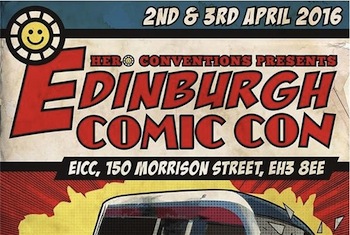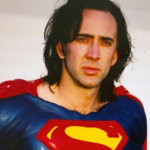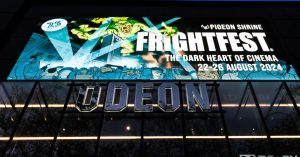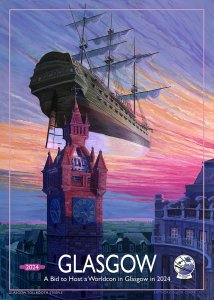 Taking place on 2nd and 3rd of April, Edinburgh Comic Con returned for its biggest year yet. Most significant was the venue upgrade to the Edinburgh International Conference Centre, giving the whole arrangement a far more professional appearance. That’s not to say that the previous two years in Potterrow were slapdash and shoddy affairs. Far from it, the limited space was used in as efficient a capacity as possible, but with the change from a glorified student union to a business centre hall designed precisely for large-scale gatherings such as these, the instant impression was that this was exactly what it always should have looked like.
Taking place on 2nd and 3rd of April, Edinburgh Comic Con returned for its biggest year yet. Most significant was the venue upgrade to the Edinburgh International Conference Centre, giving the whole arrangement a far more professional appearance. That’s not to say that the previous two years in Potterrow were slapdash and shoddy affairs. Far from it, the limited space was used in as efficient a capacity as possible, but with the change from a glorified student union to a business centre hall designed precisely for large-scale gatherings such as these, the instant impression was that this was exactly what it always should have looked like.
The venue allowed for a much better set up for the stall holders, with enough space for people to stop and browse on either side while leaving enough space for traffic to flow between them. There was also a greater variation in the exhibitors, and as well as the perennial regulars of Scotland’s indie comics scene there were also stalls for models and craftwork, geeky trinkets of all varieties and even a sweet stall. The extra room also allowed for the inclusion of several display models for impromptu photos, including a TARDIS, a speeder bike backed by a forest screen, an X-Wing, a lifesize Jabba the Hutt and a model Babylon 5 (not “the one used on the show” as a disappointingly large number of people enquired).
The panel area was a room annexed from the main hall proper so it was largely insulated from the general hubbub, but close enough to still feel a part of the main event. Comic book scholar John McShane was on hand again to chair many of the panels, his encyclopaedic knowledge stimulating discussion and primed to keep things going during lulls in conversation. Starting things was a lightly attended (it was Saturday morning, after all) panel on 2000AD, featuring Gordon Rennie (“a man who has closed several games companies”), Emma Beeby (“the first woman solo writer of Judge Dredd”) and Tom Foster (“an upcoming mega-artist”).


Being 2000AD, there was a fair bit of talk about Judge Dredd, of how interesting a character he is to get into the head of, and how he has a habit of taking over the creative process, practically dictating to the writer what he will and won’t do. From the art side of things Foster talked about how when taking over a character, particularly one as iconic as Dredd, it can be tempting for an artist to put their own stamp, despite it being self-indulgent, and that capturing the essence of a character is more satisfying than creating your own version of it. Also, there was an interesting but unelaborated upon statement that we could look forward to some “very special things” in 2000AD’s upcoming Prog 2000 that “may involve Rogue Trooper.”
The conversation took a few tangents such as going into Rennie’s work writing for gaming (“the pay’s better, but it’s less fun”) and its rigid requirements being far more constrained that the open worlds of comics writing. Additionally, Beeby’s talk of writing Doctor Who audio dramas was an interesting look at the differences between writing for the entirely visual medium of comics to one with no visuals at all and the challenges of such a radical format change.
One of the most packed panels of the weekend was a talk with actress Patricia Tallman, best known for playing über-telepath Lyta Alexander in Babylon 5, and during the 18 years since its conclusion she appears to have forgotten to age. Hosted by the Con’s mastermind James Lundy and his podcast co-host Doug Adamson, Tallman was an effervescent presence armed with a litany of anecdotes from a varied career from her early days playing a far less passive Barbara in Tom Savini’s remake of Night of the Living Dead to her recent charity work.
Each tale was told with enthusiastic relish and more than a little gleeful giggling at their sheer ridiculousness, such as and “screaming, writhing and humping the floor” when auditioning as a witch for Army of Darkness; how night shoots, burning arrows and a flammable costume do not make a good combination; and falling asleep while filming a mortuary scene on an episode of Castle and waking up afterwards when practically naked, made up as a corpse and covering herself with a sheet and Nathan Fillion choosing that exact moment to rush in to tell her what a big fan he was. There was also equally animated talk about her career in stunt work (“I fell into it”); how things have changed for female characters (“Why are we always in peril in our underwear?”); and the equal viability of older female action stars as male ones (“Harrison Ford is a thousand years old and he’s still doing it and we still love him”).

Comic Creators Anonymous was a talk with Jorge Jimenez and Bruno Redondo, Spanish artists working mainly for DC, discussing the current state of the comic book industry as perceived by creatives from a different culture. A good viewpoint was that while the international immersion of American culture means that while everyone will be familiar with certain characters, other countries have varying perspectives of them, and so they will ultimately mean different things to different people.
The paper vs digital debate carried on and raised a number of interesting points, such as with more artists doing their work digitally, it means less pieces of original artwork around, while for many comics it no longer exists. If the volume of comics produced digitally continues to increase, the suggestion of a Spotify for comics was a truly awesome idea. Digital production has also allowed for increasing numbers of independent titles, whose success comes from their ability to maintain a connection to their audience, something that larger publishers often lose sight of. Also, despite the proliferation of adaptations, the comics themselves will never truly disappear since all the films and TV shows that are based on them are encouraging more and more people to pick up comic books in the first place.
There was the occasional pause when Jimenez occasionally needed a question translated but it didn’t interrupt the flow of conversation, and as was pointed out, when Grant Morrison once attended a convention in France he had to be ‘translated’ into English before his answers could then be translated into French. It also let to an interesting point that when English isn’t the artist’s first language and requires the writer’s scripts to be translated, how much of the initial work is being preserved?
The Star Wars panel was next, beginning with McShane declaring, “In true comic convention style we have people from TV and film.” The guests were Femi Taylor, who played the ill-fated Twi’lek dancer Oola in Jabba’s palace at the beginning of Return of the Jedi, and Arti Shah, who performed the motion capture for former smuggler queen Maz Kanata in The Force Awakens.
Taylor had fond memories of an experience that was a small but nevertheless significant part of her life, from her audition that was shrouded in secrecy to her return some 15 years later to perform reshoots for the Special Edition, the only actor who was asked to do so, even going so far as to have a set built for the filming. She also had nothing but nice things to say about the movie’s principal cast – Mark Hamill in particular being a “sweetie” – and mentioned the intense practicality of the filming, her Twi’lek tendrils being so heavy they threatened to throw her off balance while dancing.

Not completely focused on Star Wars, the talk also touched on the difficulties and complications of being a little-known actor, and how much dedication and effort is required to sustain yourself in a competitive industry. While agents stated to be the most important aspect, equally stressed was the willingness to constantly put yourself out there. Shah in particular, who as a little person has to work even harder to properly establish herself and avoid the stereotypical roles she is frequently offered.
The day finished with a Q&A from professional cosplayer Tabitha Lyons and her dad Nic Samiotis, operators of prop studio Artyfakes. There was some introductory talk from the pair about what they do, but it was for the most part a forum for enthusiasts to voice any queries they had about the creative process of costume and prop making. With a large proportion of the audience sporting the colourful vibrancy of their own creations, there was no shortage of questions. A vivacious dynamo of a woman, Lyons’s popularity in the UK cosplay scene is easy to understand, and her effervescent enthusiasm for her craft came though in every moment such as talking of how cosplay has massively increased her self-confidence, and even when mentioning some of her negative experiences, she kept a broad smile on her face. Samiotis, meanwhile, could talk at length and with equal passion of the intricacies of creating anything out of foam and latex and the different practical applications of various types, and was a little more esoteric in some of his own cosplay choices, stating a desire to dress as Marvin the Martian and The Muppets’ Swedish Chef.

Sunday began with a panel on fan films, featuring Nick Cook and Steve Hammond, who have been making the Star Trek Intrepid series of fan shorts for about a decade, and blogger Craig McKenzie, a regular reviewer of such work. First came a screening of the latest instalment of Intrepid, titled Nemo Me Impune Lacessit, which if you don’t know is the Latin motto of Scottish royalty and roughly translates to “Come and have a go if you think you’re hard enough.” While nowhere near the same scale as the Axanar short screened last year, the production values on display were still pretty impressive, while the effects work went far beyond what you would expect.
Some non-Trek talk gave things a little variation, such as touching on Adi Shankar’s Bootleg Universe and how fan films can be used to explore alternative interpretations of established characters, as well as some of the technical side of things like how advancing technology has made the filmmaking process easier, that you’ll often end up filming anywhere you can in awful conditions to get the shot you need, and when starting and continuing to make a film you can by definition never make any money from the enthusiasm is sometimes all you have.
Lundy and Adamson returned next for another talk, this time with Canadian actor Cas Anvar, veteran of a legion of supporting film and TV roles, most recently as pilot Alex Kamal in Syfy’s utterly magnificent ensemble series The Expanse. As it turns out Adamson was educated as a physicist and so much discussion went into the show’s scientific plausibility: to create an industrial colony the asteroid Ceres has been hollowed out and spun to create gravity which leads to a visible Coriolis effect, the ships in space only having gravity in motion, the mechanics of space flight adhering to the laws of physics meaning a ship can’t just suddenly brake to a halt as seen in Star Trek, and also talked about the complicated practical effects required to mimic the lack of gravity in deep space. Now, for the love of something sacred let UK viewers have it already!
There was also a lot of talk about his work on Assassin’s Creed as Altaïr, the “Captain Kirk of the franchise,” his fascination with the character’s history and the motion capture work that made him look like a “little worm with dots;” vampire horror series The Strain, where his initial two-episode stint has been expanded until at least the end of season three. Anvar also discussed how voice acting allows “ethnically diverse” actors take on roles that live action would usually deny them, allowing him to be “a 300lb Russian general, a duck-faced alien and a redneck Irish military lieutenant.” His easygoing charm and deadpan sense of humour made you feel that instead of a convention celebrity being interviewed, it was more like listening to one of your mates down the pub talking about his job. And as a truly awesome parting shot, he challenged people to swing by his convention table and if they scored high enough on an Assassin’s Creed test, he would record a voicemail greeting for them as Altaïr.

The Game of Thrones panel featured Ian Hanmore (Qarth’s creepy warlock Pyat Pree), Kerry Ingram (doomed princess Shireen Baratheon, the daughter of Stannis), and Miltos Yerolemou (Arya’s swordfighting instructor Syrio Forel). From stories of the audition process (Yerolemou, when asked about his swordfighting experience: “for the very first time I didn’t have to lie”) to stories from the set (Ingram filming her debut scene with a broken foot and faceplanting into Stephen Dillane), all three clearly retain a great deal of affection for it despite it no longer being a part of their lives, and consider it a source of pride to have been a part of it.
Inevitably, the first audience question asked was whether Syrio is still alive, but since George RR Martin wrote his final moments in first season episode ‘The Pointy End’ to be intentionally ambiguous, Yerolemou genuinely doesn’t know. As is ever the case with Game of Thrones, there was some speculation about where the TV show will go now that it’s caught up with the books, and since the TV show will end before the books are complete if the inevitable differences will affect people’s enjoyment, to which it was pointed out that intense deviation from the source material certainly hasn’t done The Walking Dead any harm.
There was also discussion on the ever-evolving transmedia state of TV and it now being an individual rather than communal experience, and despite this Game of Thrones remains one of the few things that absolutely everyone watches and discusses afterwards, while the scores of fan theories flying about are a testament to just how much the fans of the show have embraced its world.
Next up was a movie screening of cult Scottish comedy Electric Man, in which the owners of a comic book shop facing eviction find themselves apparently saved after coming into possession of an ultra-rare comic book. However, a ruthless collector of rare comics, a Glasgow thug, and a suitably mysterious young woman in a black cape are hunting the comic. Somewhat surreal chaos ensues as everyone gradually stumbles towards the truth behind the comic’s existence.

Equally parts charming and anarchic, it was the perfect film to screen at a convention, not just because of having a comic as its Macguffin, but also because it fully acknowledges the passion that drives many in the relentless pursuit of the next addition to their collection, and does so in a way that refuses to make fun of such obsessions. The film makes good use of its Edinburgh locations; even featuring the previous site of local stalwart Deadhead Comics for its shop interior shots, while is characters are an engaging assortment of oddballs who keep things interesting with their varying levels of crazy. The story gets a little too convoluted for its own good towards the end, but everything is ultimately resolved in a complete and satisfying manner.
Once again the weekend finished off with a cosplay contest, where a wonderfully diverse assortment of imaginatively realised characters paraded for the pleasure of an appreciative audience. A few of them included Game of Thrones’ Mellisandre; The Hunchback of Notre Dame’s Esmeralda; Wolverine in his X-Force costume; a Golden Age Flash; a samurai First Order stormtrooper; Poison Ivy in a mix of her classic and New 52 looks; a female Predator in a skimpy two-piece; a bizarre yet compelling hybrid of the Skyrim Dovahkiin and Boba Fett; a Lara Croft greeted with equal parts enthusiasm and unease after revealing herself to be an alarmingly convincing cross-dressed man; a female Thor striking some suitably dramatic poses; Trapjaw from Masters of the Universe brandishing some wonderfully intricate homemade armaments; a “fresh” zombie from The Walking Dead; and metafictional fangirl Osgood from Doctor Who.
As vibrant and colourful as the lineup was, it was ultimately a contest, and the winners were highly deserving of the accolade. Third place was won by Arcade Riven from League of Legends, wielding a sword almost the same size as she was and festooned with green LEDs programmed with flashing sequences; the runner up was Christine Daaé from Phantom of the Opera (although nobody she encountered over the course of the weekend actually recognised the character) in a truly stunning homemade dress; and the winner was Chappie from the 2015 sci-fi film of the same name, with an amazingly intricate duplication of the eponymous sentient robot that looked like it could have come straight from the set of the film. You can expect an interview with him in a future edition of the magazine.
In only its third year of operation Edinburgh Comic Con has taken a massive leap forwards with a bigger venue, bigger guests and a vastly increased attendance. With the level of passion and dedication it has both behind it and participating in it, it can only continue to grow, so we can only imagine what next year will bring.









No comment yet, add your voice below!